Robert Lamb ~ Filmation Studios ~ Breaking In
1981 - My First Year at Filmation - Apprentice Storyboard Artist

Robert Lamb ~ Filmation Studios ~ Breaking In
1981 - My First Year at Filmation - Apprentice Storyboard Artist
Epilogue
I was given a desk in Rich Fogel's office. Rich was one of four assistant storyboard supervisors working under Karl Geurs. In the Reseda studio each office in the storyboard wing was shared by two artists. My first assignment was to clean up Don Manuel's roughs for "The New Adventures of Zorro." I tried really hard but I was out of my league. Don's boards were so good I felt I was taking them down a notch rather than doing them justice.
Rich and Don were very helpful and gave me tips, shortcuts and encouragement. But for those two weeks I was on pins and needles. I thought Karl would regret hiring me and I'd be out on the street, pronto!
At the end of the second week I summoned up all the courage I could muster and knocked on Karl's door. He beckoned me in and asked me what I wanted.
"Uh, should I still come in Monday?"
"What?" Karl blinked at me. "Why wouldn't you come in Monday? Is there a problem?"
"You said I was on two weeks probation."
Karl leaned back in his chair and laughed. "I had completely forgotten about that! Of course you come in Monday. I would have let you know long ago if you weren't working out."
I nearly collapsed from the sigh of relief I exhaled. Thanking Karl, I left the building and headed home. I really had made it!
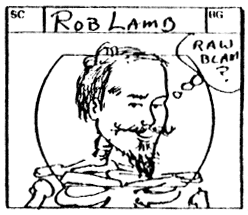
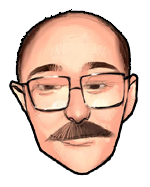

Next,
“The New Adventures of Zorro!”


Go West Young Man!
I moved to Los Angeles from Phoenix, AZ, my hometown, during the Bicentenniel, July 4, 1976 to seek fame and fortune in Tinseltown, but found neither. I worked at various odd jobs while I studied art at the Art Center College of Design in Pasadena.
I dreamed of working at Walt Disney Studios and had an interview with Ed Hansen, the president of Feature Animation in the 1970s but my drawing skills weren't at their level. I took inbetween classes at Hanna-Barbera at night but still no job.
I applied for an entry level inbetweener job at Filmation in 1979. Don Christiansen was the producer then and asked me if a particular drawing of Tarzan was my original work. Stupidly, I said it was, not thinking he would have the same Burne Hogarth book from which I copied it. Again, I was shown the door.
I got a few art gigs but nothing substantial. Then I received some good advice from a friend who observed that my best work was my idea sketches. My finished artwork was okay but not outstanding. With several art schools in the greater L.A. area churning out excellent artists and illustrators every year, competition was fierce.
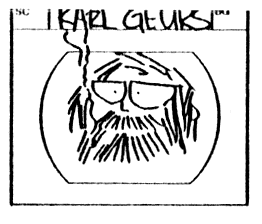
Karl Geurs caricature from 1981 season storyboard staff book of toons.
The Interview
Karl Geurs was a big bear of a man with thick glasses and a full beard. He chuckled at my space board and said I had an eye for film though my screen direction needed work. He also said my drawing limitations put him in a tough spot. He needed board artists and it appeared I might be able to do the job but my draftsmanship was iffy. Karl decided to test me and gave me a page from a Lone Ranger script. Normally, he would have an applicant board a page or two of a script, but Karl pointed to just one line and said draw as many angles or setups as I could imagine. He handed me some storyboard paper and said to call him when I had something.
Filmation storyboard paper at that time was small and cramped with nine panels on letter-sized paper. Each panel was about 2.5 x 1.75" with a tv cutoff frame inset that was about 1.75 x1.25". I learned later we were supposed to compose each shot within the tv cutoff because that is what the audience would see. The full frame is what would be within the film frame. We had to draw in this tiny frame, not larger and reduce on a copier. The typical response about wanting to draw larger was: "If you want to draw, join the Layout Department."
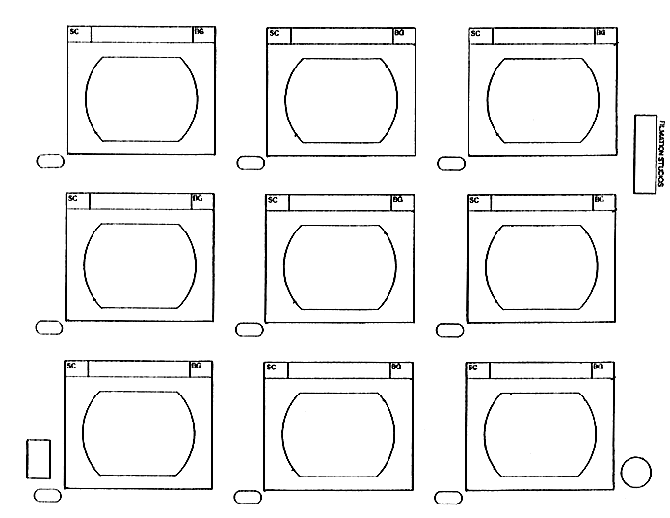
A Door Opens
In 1981, I was working at Aaron Bros. Art Mart, a picture frame and art supply store in Studio City, CA. Robert Kline, a Filmation storyboard and development artist, brought some of his art into the store to frame. While I helped him with picture framing I told Bob about my earlier attempt to join Filmation. Instead of brushing me off, he told me Filmation needed storyboard artists. I didn't think one could reach the story department until after serving time animating. Bob said that storytelling and knowledge of film was as important as drawing skill at Filmation. Some fine veteran animators aren't able to visualize scripts and board them even though they could bring characters to life through their animation skills. I guess it is comparable to actors writing or directing in live action. Some can, others can only act. Storyboarding is a unique talent. Bob encouraged me to call Karl Geurs, the storyboard supervisor, if I was interested.
Of course, I was interested! I couldn't wait to get home and put my portfolio together. I pulled out all the finished pieces and just concentrated on my sketches. But I didn't have any storyboards. So I took a few days and created a sci-fi space battle scene and chase. When I thought I had enough to show, I called Karl Geurs at Filmation to arrange an interview.
Filmation storyboard paper, circa 1981
The Test
I rushed home and got to work immediately.
The single line in the Lone Ranger script described the hero giving bad news to a farmer who just lost his ranch on a legal deal. The line read: "The farmer's shoulders slump in resignation." That's it? My whole future depends on illustrating six words? I sharpened my pencil and started drawing.
I drew the Lone Ranger leaning against the farmer's front porch post with the farmer sitting hunched over on the stoop. I did close-ups of the farmer wringing his hands. I staged the scene inside the farmer's house by a stone fireplace. I had the Lone Ranger and Tonto exchanging worried looks as the farmer buried his head in his hands. Within about twenty minutes I had filled the page. That can't be enough! He won't give me a job for such little effort. So I drew another nine setups for a total of eighteen.
Then I called Karl. He said he couldn't see me until the next day.
The Results
After a sleepless night I brought in my two pages. Karl Geurs looked at the thumbnails and said, "You're hired!"
"You're kidding!"
Karl sat back in his chair and smiled, "The most I have ever gotten from this test is three setups. You gave me eighteen!"
Then Don Christiansen stepped into Karl's office wearing a Hawaiian shirt and Bermuda shorts. I hoped he didn't remember me from two years earlier. Karl showed Don my storyboard test.
"This is the guy I told you about."
"Hmmm, I see what you mean, " Don muttered as he studied the board. "Too bad he doesn't draw worth a crap!"
Okay, I died just then. My future fizzled in one phrase.
"Still, he does know film. Hire him if you want." The sadist winked at Karl and left.
When my heart restarted I could hear Karl saying something about giving me two weeks probation to see if I can fit in and do the work. I nodded and said I would do my best. He told me come in the following Monday morning.
I couldn't believe it. After many attempts I finally broke into the animation business!
Two Weeks Probation
The weekend couldn't pass by fast enough for me. I celebrated and worried and fretted. I expected there to be a big mistake and told there was no job after all.
It was a warm Monday morning in May 1981 when I walked through the doors of Filmation Studios in Reseda, California as an employed storyboard artist.
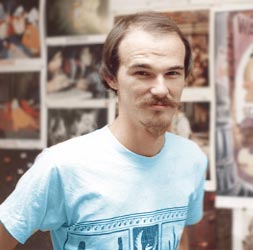
Rob Lamb, Filmation storyboard apprentice, August 1981
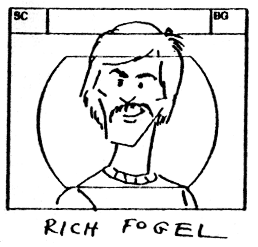
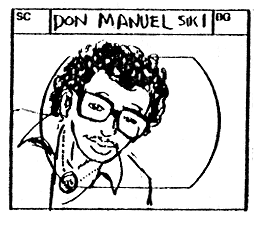
See "Legal Stuff" for copyright information about Filmation and other entities mentioned here.
All other original material on this website is copyrighted by Robert Lamb.
Contact me at robertartwriter@gmail.com
Featured in cereal:geek issue five
by James Eatock